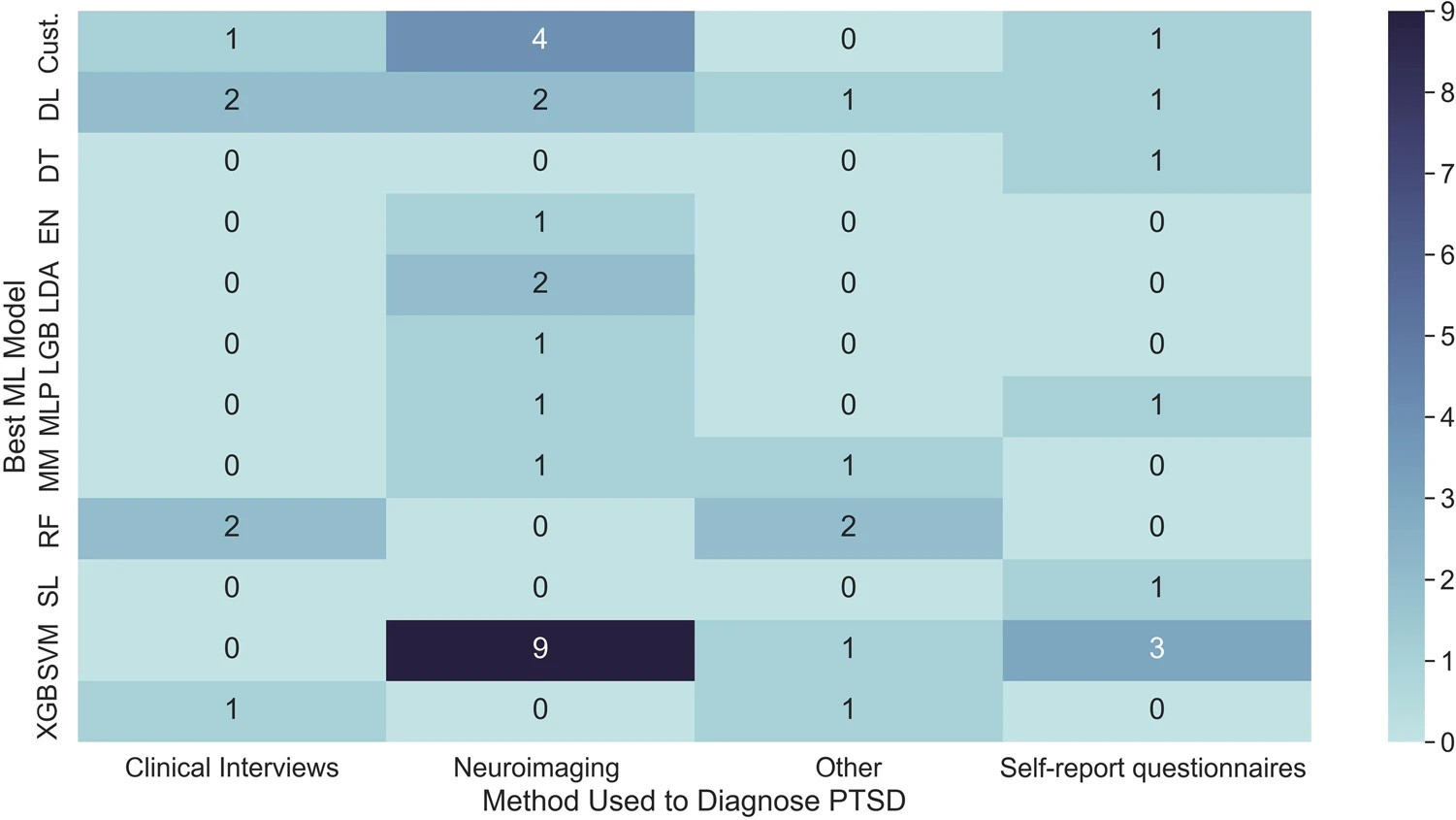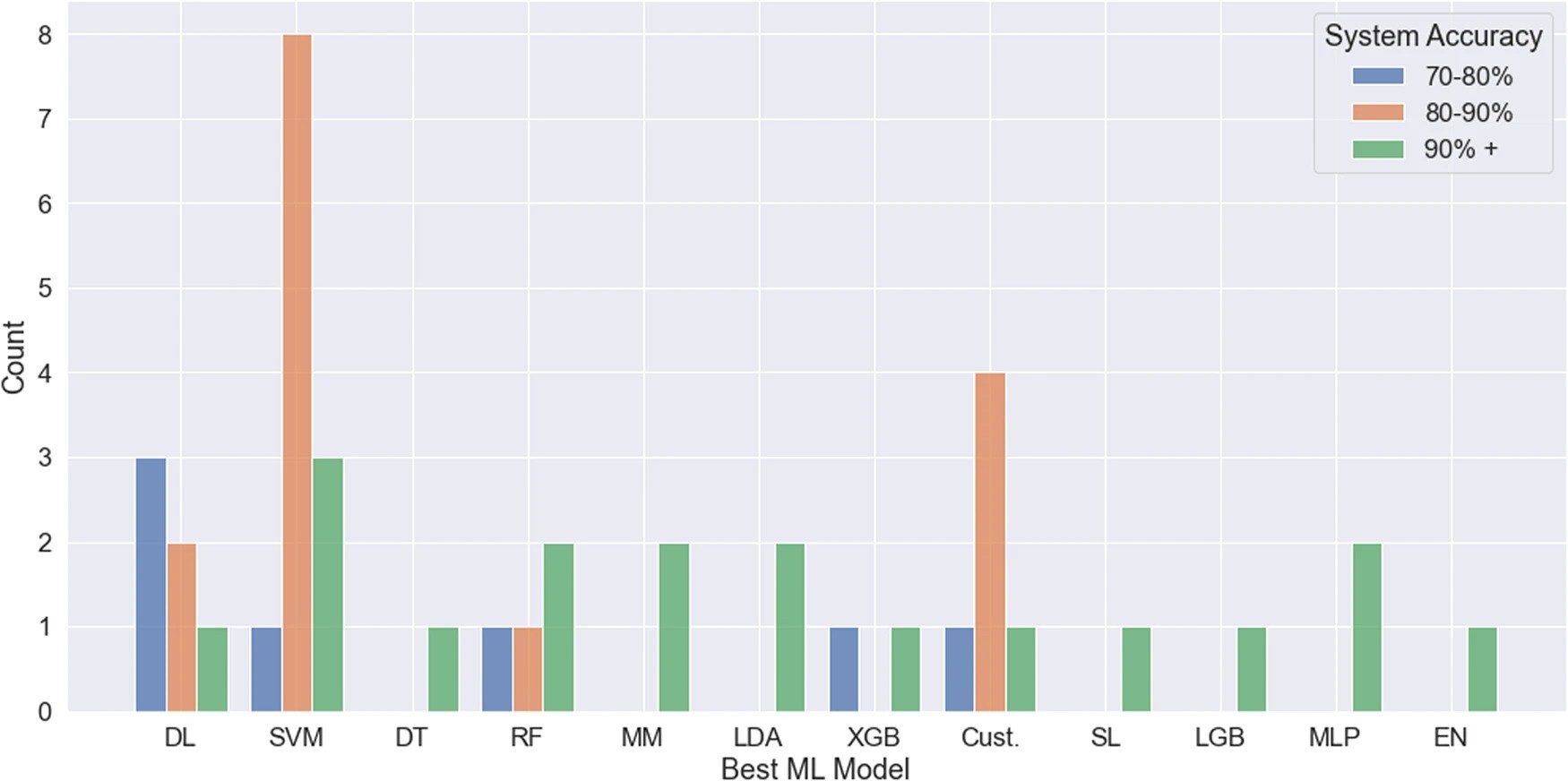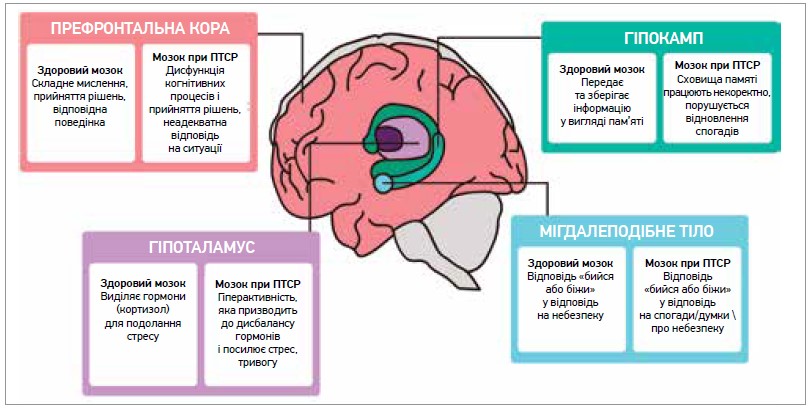
Russia’s war against Ukraine, which has been going on since 2014 and escalated after the full-scale invasion in February 2022, has left a deep and severe mark on the mental health of Ukrainians, including military personnel. Post-traumatic stress disorder (PTSD) has become one of the most common problems among both civilians and those who took part in the fighting. Back in 2024, among the diagnoses of «neuralgic stress-related diseases» among soldiers, PTSD accounted for 29%, reported Ministry of Defense.
As of the end of June 2024, the Electronic Healthcare System registered 27,544 Ukrainians diagnosed with post-traumatic stress disorder. In general, the prevalence of PTSD in Ukraine in 2023 is as follows was about 25%. In addition, half of the population (57%) is at risk of developing this mental health disorder. Among the military, this figure may be even higher. As for civilians, at least 15 million Ukrainians will need psychological assistance after the war, including about 3-4 million will need of medical treatment.
Unfortunately, many people do not have the opportunity or does not want to seek help to specialists for one reason or another. However, with the advent of new technologies, the use of artificial intelligence (AI) for the diagnosis and treatment of PTSD may become a more convenient and affordable alternative to visiting a psychiatrist.
Content
What is PTSD and why it should not be underestimated
This is a mental disorder that develops after experiencing traumatic events, such as combat, loss of loved ones, violence or constant stress, or the birth of a child. Interestingly, German neurologist Hermann Oppenheim was the first to coin the term «traumatic neurosis» in 1889. He used it to describe the symptoms that victims of accidents during railroad construction had. Back then, it included a wide range of symptoms. Now this list has been narrowed.
Symptoms of PTSD include intrusive memories (flashbacks), nightmares, avoidance of situations that remind you of the trauma, increased anxiety, depression, and sleep disturbances. Feelings of anger or alienation towards other people, overreaction to things like a loud sound or accidental touch, and a sense of invincibility. And these are just the external manifestations. PTSD is not just about emotions and mental state. It changes the brain of the affected person.
For Ukrainian soldiers who face extreme conditions on a daily basis, these symptoms can develop into chronic ones, affecting their ability to perform their duties, maintain social relationships, and adapt to normal civilian life. Experts estimate that up to 20-30% of combat veterans in Ukraine may suffer from PTSD or related disorders. However, it is difficult to establish exact figures, as there is still a stigma attached to mental health problems in society, and access to quality psychological care is quite limited, especially in conflict zones.
Conventional methods, such as cognitive behavioral therapy (CBT) or medication, often require significant resources, a lot of time, and highly qualified professionals, which are critically lacking in Ukraine.
Diagnosis of post-traumatic stress disorder usually takes up to six months after the trauma, and during this time it can become chronic. And in general, less than half of people with mental disorders receive therapy, and those who do, on average, receive only 45 minutes a week. This is where artificial intelligence (AI) can be helpful. The right smart digital assistant can not only facilitate diagnosis, but also suggest therapies tailored to individual needs. Moreover, it is available around the clock and is not as expensive as a regular specialist.
From Eliza to Therabot
Artificial intelligence proved its effectiveness in medicine. It is able to analyze various medical data (e.g., medical history and medical images — from ultrasound to CT scan) to predict the development of a disease or the effectiveness of treatment for tuberculosis and cancer. Despite 83% skepticism believe AI is useful.
In the context of mental health, AI offers tools that allow for faster detection of disorders, personalized therapy, and real-time support.
In March of this year published The first clinical trial of a therapeutic generative AI botwhich showed the same effectiveness as a human expert. The team, led by psychologists from the Geisel School of Medicine at Dartmouth College, developed the tool called Therabot. The test was conducted on adult participants with depression, anxiety, or risk of developing eating disorders.
They managed to get around three problems:
- A therapeutic bot can harm a patient by giving incorrect answers. Therefore, such bots were developed with the help of complex detailed programming: The software chose answers exclusively from a limited store of approved responses. For example, this was the case with ELIZA, a psychotherapy program developed in the 1960s. By the way, the Eliza effect is named after this virtual interlocutor. It was the first program created to imitate natural human speech. However, it turned out that it gave people the illusion of real communication. Users unconsciously attributed human traits to Eliza. Do you talk to ChatGPT as a friend or a mentor with a personality of its own? Do you think that a car has «mood»? Well, this is the Eliza effect in action. Back to the topic: such limited communication, as it was in the case of ELIZA, quickly got boring and people lost interest.
- In a good therapeutic relationship, a patient, and a doctor must have common goals and a desire to cooperate. It is very difficult to achieve this with software. In 2019, researchers at Dartmouth realized that generative AI could help overcome these obstacles. They started creating an AI model trained to give evidence-based answers. First, they tried to build it based on common conversations about mental health from online forums. Then they turned to transcripts of real sessions with psychotherapists. But the result was a bot that wrote back: «Hmmm», «Continue», and «Your problems arose from your relationship with your mother».
- Therabot’s developers also noticed that most therapeutic AI bots on the market were just variations on basic models, such as Meta’s Llama, which were trained primarily through online conversations. This also posed a problem, especially for topics related to eating disorders (e.g., bulimia, anorexia, binge eating, picaresque eating, and others). The bots turned out to be sycophants. If a person said they wanted to lose weight, they started to support this idea. Even if the user was underweight. A human therapist would not do that.
To test Therabot, the researchers conducted an eight-week clinical trial with 210 participants who had symptoms of depression, generalized anxiety disorder, or were at high risk for eating disorders. Approximately half of them had access to Therabot, while the control group did not. Participants answered questions from the therapeutic AI and initiated conversations. On average, they received about 10 messages per day.
Participants with depression reported a 51% reduction in symptoms, which was the best result in the study. Anxiety sufferers reported a 31% reduction in symptoms, and people at risk of developing BED saw a 19% reduction in body image and weight concerns. The measurements were based on self-reported data.
This method is certainly not perfect, but it is still one of the best tools researchers have. These results were about the same as in the control group, where a human therapist provided 16 hours of treatment. At the same time, Therabot achieved these results in about half the time.
It seems like everything is great, you can help a lot of people! But there is a nuance. While AI is advertised as a therapy in a legitimate, clinical context, in the US, it is subject to regulatory oversight by the Food and Drug Administration (FDA). And there are serious doubts about obtaining approvals. If these types of digital therapies are not approved and integrated into healthcare and insurance systems, it will severely limit their reach. And the people who could benefit from such AI bots will begin to seek emotional support and psychological help from AI types that are not designed for this.
For example, a February report from OpenAI showed that ChatGPT is used by 400 million people every week. And not all of them are looking for «just a friend» and a dinner recipe generator. Some are also trying to use chatbots to support their mental health. However, chatbots are not adapted for such interactions and can cause harm in the case of PTSD.
How AI can help cure PTSD
But so far, what the Therabot authors have said looks more like self-promotion. On the other hand, this is still the first convincing evidence of the benefits that a really well-designed AI can bring as a psychotherapist. As for PTSD, a different approach is needed. But some technological steps have already been taken in this direction. There are several interesting research papers that show promise.
For example, some people may pretend to have some symptoms or exaggerate. Why? To get benefits, financial compensation, attention, or prescription drugs. This, among other things, leads to specialists spending valuable time on those who do not need their help at all.
That is why scientists created an intelligent AI system called the VeRITAS algorithm that can detect when people are lying about symptoms of post-traumatic stress disorder.
The study was conducted with 651 people of different genders and races, including US veterans, psychiatrically healthy representatives of the general population of the US and the UK, and mental health professionals. The results of the VeRITAS algorithm were exceptional: the accuracy of counterfeit detection was about 95%, and the test took less than 4 minutes. Even mental health professionals failed to «outsmart» this program.
More research was about the effectiveness of ChatGPT and the text-embedding-ada-002 (ADA) model in the rapid diagnosis of postpartum posttraumatic stress disorder (PP-PTSD). Every year, approximately 140 million women give birth in the world. For about a third of them, childbirth can be a serious stressful or traumatic experience.
While PTSD is more commonly associated with combat or serious sexual violence, childbirth is also increasingly recognized as a serious trigger for PTSD. Among women in labor, approximately 6% exhibit the full spectrum of PTSD, which is more than 8 million women annually. Untreated PTSD has not only negative consequences for the mother and child, but also has significant social costs. Therefore, it is important to start early treatment of PP-PTSD.
Scientists tested whether it is possible to detect postpartum PTSD (CB-PTSD) in women by their text stories about childbirth. They tested ChatGPT and language embeddings Text «translates» into a set of numbers that preserve the meaning and content of words, sentences, or entire stories.. Conventional ChatGPT turned out to be ineffective, while the model based ontext-embedding-ada-002
Text «translates» into a set of numbers that preserve the meaning and content of words, sentences, or entire stories.. Conventional ChatGPT turned out to be ineffective, while the model based ontext-embedding-ada-002 A model from OpenAI that is very good at «sensing the» meaning of text. was accurate and reliable (up to 85% sensitivity). This approach made it possible to identify traumatic childbirth experiences in a timely manner without questionnaires or doctors.
A model from OpenAI that is very good at «sensing the» meaning of text. was accurate and reliable (up to 85% sensitivity). This approach made it possible to identify traumatic childbirth experiences in a timely manner without questionnaires or doctors.
Tools for working with traumatized people and their cognitive behavioral therapy are also being developed, such as Capstone project. This is an intelligent cognitive system, such as an AI agent, that can potentially interact with patients in their familiar environment and help manage symptoms in real time, track emotional patterns, and offer immediate support.
In general, there is little research on the use of AI for diagnosis or therapy in PTSD. However, in 2025, the journal Behavioral Sciences analysis published on the application of artificial intelligence in various fields. According to it, since 2017, there has been a significant increase in publications on AI and PTSD.
AI has a high potential due to its ability to detect early symptoms of PTSD, create personalized treatment plans, and continuously monitor patients. However, there are still many challenges in algorithm development, data integration, and ethical issues.
Modern chatbots, such as Woebot or Tess, use natural language processing algorithms to provide psychological support 24/7. They can conduct conversations, suggest relaxation techniques, or help recognize PTSD triggers. For example, research, published in the NEJM AI journal, showed that chatbots based on generative AI can effectively reduce the symptoms of depression, which is a frequent companion of PTSD. Or provide emergency assistance in case of a panic attack.
A bit older research (from 2023) included various machine learning (ML) algorithms in the automated diagnosis of PTSD. And this, as mentioned above, is necessary for the rapid detection of a mental health disorder.
The researchers used statistical methods to summarize the results of the included studies and provide recommendations for implementing key aspects of machine learning (ML) tasks: selecting the best ML model for a given data set, determining the optimal ML features for diagnosis, setting the optimal sample size depending on the data distribution, and using appropriate tools to evaluate and validate the effectiveness of ML models.
Two researchers independently reviewed the data and reconciled differences through discussion. The analysis included publications in English that used machine learning models for automated diagnosis of PTSD and contained indicators of model performance. The search included the Embase, MEDLINE, Scopus, PsycINFO, Compendex, and IEEE Xplore databases for the period from 1946 to 2022 inclusive. Out of 3186 records, 41 publications were selected for the final analysis. These were both audio and text data obtained from combat veterans during interviews.

As it turned out, many models showed high accuracy (up to 89.1%) in identifying PTSD. However, the best performers were deep learning (DL) models — such as CNN, RNN, LSTM, support vector machine (SVM), and mixed models (i.e., combinations of several ML approaches).

The researchers concluded that machine learning is promising. However, the effectiveness of ML models for PTSD classification is affected by limited sample size (overfitting), especially in neuroimaging and clinical interviews, the impact of comorbidities such as depression and anxiety disorders, and medication use.
But what’s interesting is that mixed models were effective because they analyzed both textual descriptions and audio. In one of the older researchIn a study involving 52 veterans of the Iraq and Afghanistan wars with PTSD and 77 veterans without the disorder, the researchers noted the effectiveness of audio analysis. The algorithm identified 18 factors (such as tone, tempo, and pronunciation) associated with PTSD from the voices. Using these markers, the program correctly identified patients with an existing diagnosis in 89% of cases.
How AI can help the Ukrainian military
It is difficult or almost impossible for soldiers in remote areas to get timely access to psychologists. AI-powered mobile apps could provide them with much-needed support 24/7. Specialized software could also be useful for those who have returned from the frontline and want to adapt to civilian life.
Artificial intelligence (AI) has shown its potential effectiveness in the diagnosis and treatment of post-traumatic stress disorder (PTSD). It can quickly analyze large amounts of data, detect patterns quite accurately, and tailor therapy to individual needs as precisely as possible.
So, in theory, it would be possible to create an application that would analyze behavioral data, physiological indicators (for example, heart rate or stress level via smartwatch), text messages, and the user’s voice. But so far, Ukraine lacks large databases on PTSD that could be used to train AI. And most models, such as Therabot, are trained on English-language sources. AI can misinterpret emotional expressions or specific traumatic events related to war.
We don’t have AI therapists yet. But Igor Sikorsky Kyiv Polytechnic Institute students are exploring this possibility. For example, Eldar Aliyev studies how machine learning and artificial intelligence can be used to analyze magnetic resonance imaging (MRI) to quickly identify biomarkers of PTSD. In the long run, this would help in the early diagnosis of the disorder.
In another study Hlib Bykov suggests combining electroencephalography (EEG) with a neural network to quantify the state of the central nervous system. The author points out that this is a cheap and easy-to-use way to detect PTSD based on available patient data.
In general, although «smart» algorithms demonstrate effectiveness in reducing symptoms of depression or anxiety, PTSD is a more complex disorder that requires a deep emotional connection between therapist and patient. Therefore, AI is likely to be a useful complement, but it will not be able to fully replace human specialists. Perhaps Ukraine will be able to develop the most effective model for diagnosis or therapy?



Spelling error report
The following text will be sent to our editors: